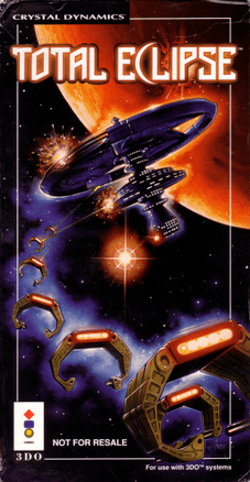Producer(s) Jon Horsley Initial release date 1994 | ||
 | ||
Similar Crystal Dynamics games, Shooter games | ||
Total Eclipse is a space shooter for the 3DO. It was later ported to the PlayStation under the title Total Eclipse Turbo. The game was copyrighted in 1993 but not made available to the public until 1994, leading some sources to mistakenly list its release date as 1993. A sequel, Solar Eclipse, was released for the Sega Saturn and Sony PlayStation.
Contents
Plot
Earth is attacked by an aggressive alien race known as the Drak-Sai. The aliens use their powerful weapon, the Sun Dagger, to initiate a supernova in the sun. The player must pilot his ship across four planets and ultimately destroy the Sun Dagger to prevent further destruction.
Gameplay
The game is played in a third person, behind-the-player perspective as the player's ship flies a predefined path across each level. The player is free to maneuver around to dodge obstacles and attack enemies, but the course for each level is fixed.
Gameplay is divided into two phases, surface and tunnel. In surface mode, the player flies over 3D heightmapped terrain, avoiding slamming into mountains and obstacles. In tunnel mode, the player flies through a 3D tunnel, avoiding mechanical traps such as large moving doors and twisting passageways. The player transitions from surface mode to tunnel mode by flying into a tunnel when it approaches in surface mode, and each tunnel returns the player to surface mode when the player reaches the end of the tunnel. The exit of the tunnel appears later in the surface mode of the same level, so the player may miss a power-up (or a challenge) on the surface by taking a tunnel and vice versa. Some tunnels are optional and may contain bonus items to make the player's ship stronger, while other tunnels are located at a dead end (typically with an unavoidable cliff face) in the surface mode. If the player fails to properly guide his ship into the tunnel at that point, his ship will collide with the dead end terrain and explode, costing a life.
In both modes, enemies attack the player. Colliding with enemies, being shot by enemies, and colliding with the level itself will cause damage to the player's ship, draining the ship's armor. When the armor reaches zero, the player's ship explodes, a life is deducted from the player's stock, and play resumes at a predefined point earlier in the level.
Each game level is divided into four stages, where each stage can contain multiple surface and tunnel phases. Each level (planet) has its own color scheme, scenery, hazards, and background music. The fourth stage of each level is distinguished by a different background song than the previous three, and ends with a fight against a large enemy boss.
The player is armed with two weapons, an upgradable gun and a powerful bomb. There are several types of gun, each having a different rate of fire, firing pattern, and offensive strength. This variety means that the best gun is determined by the player's play style, as well as the level itself, since some weapons are more effective above ground than underneath it. Guns are upgraded by collecting items labeled with the type of gun they represent. If the player collects (touches) a gun item that matches the gun he is currently using, the gun is upgraded by one level. A higher level gun shoots more rapidly and more powerfully, making it much more valuable. The maximum level for each gun is three. If the player collects a gun item that is different than the gun he is currently using, he trades his existing gun for the new gun, but the level of his gun remains the same. Therefore, it is in the player's interest to collect one type of gun to upgrade, and then collect others as the situation demands and keep the gun at the maximum level. The bomb weapon projects an animated wall of fire ahead of the player, destroying all minor enemies it touches and damaging stage bosses. The supply of bombs is limited, but more bombs can be gathered by collecting items labeled with a bomb icon.
The player can also collect items that serve as score bonuses. Typically these bonus points are located in places that require skillful flying to reach.
Reception
Electronic Gaming Monthly gave the 3DO version a 6.5 out of 10. They highly praised the graphics but criticized that the controls are too sensitive, the music is inappropriate for the theme of some stages, and that the hit detection is overly punishing. GamePro were held in similar awe of the graphics in the 3DO version and found little to complain about with the gameplay, concluding, "Total Eclipse blasts off into familiar fighting space ways, but the graphic look of this cool shooter is truly out of this world."
Reviews for the PlayStation version were less positive, as critics commented that despite the "Turbo" in the title, the PlayStation version made almost no changes to the by-then over a year old game. Bob Mackey of USgamer listed Total Eclipse Turbo as one of the worst launch games for the PlayStation.
